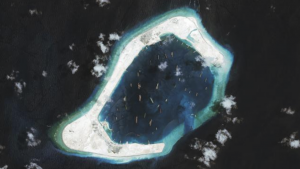Home » Commentary » Opinion » Time to round up neighbours to resist China
 If you think the Great Barrier Reef is in trouble, spare a tear for Subi Reef in the Spratly Islands. In 2014 China started pumping perhaps millions of tonnes of sand from the bottom of the ocean on to this semi-submersed formation in the South China Sea.
If you think the Great Barrier Reef is in trouble, spare a tear for Subi Reef in the Spratly Islands. In 2014 China started pumping perhaps millions of tonnes of sand from the bottom of the ocean on to this semi-submersed formation in the South China Sea.
Within a year it had created an artificial island with a hardened surface area of 400ha, boasting a commodious harbour that can shelter dozens of ships and an airport with a 3000m runway.
Western Sydney Airport project managers, take note: if you want to get the job done before 2026, China’s People’s Liberation Army Navy should be your contractor of choice.
And Subi Reef isn’t China’s only big infrastructure project in the South China Sea.
Far from it. The Chinese have built even bigger airports at Mischief Reef and Fiery Cross Reef.
Four other reefs play host to new Chinese seaports. Pity the corals.
These new island bases don’t “count” as sovereign territory under international law, but that hasn’t stopped China from pushing its claims further and further offshore.
The PLA won’t reach Australia in the near future but its proxies and minions have made a science of oceanic colonisation. First come the aggressive “fishing” boats (with no fishing gear or mandatory identification beacons), then the maritime militia, then the coastguard. Once these have established “national interests” that need protecting, the heavy muscle sails in: China’s PLA Navy.
That was the plan on display last month in Indonesia’s sparsely populated Natuna Islands, where China sent 63 fishing boats escorted by two coastguard cutters to assert its supposed exclusive economic zone in the region.
The Permanent Court of Arbitration in The Hague ruled in 2016 that there was “no legal basis” for China’s expansive EEZ claims.
China responded that the ruling itself was “null and void”, despite the fact that China has signed the UN Convention on the Law of the Sea, the treaty under which the court made its ruling.
The only hard barrier standing between China’s relentless push south and the vulnerable countries of Southeast Asia is the US Navy. Other countries have challenged China’s expansive EEZ claims but only the US runs regular freedom-of-navigation operations within the territorial waters claimed by China.
Under international law, a country’s sovereign territory extends 12 miles out from the low-tide mark of its shores, but China’s artificial islands give it no such legal rights. The US runs freedom-of-navigation operations close to these islands to drive home that very point.
Some Australian defence analysts, such as the Australian Strategic Policy Institute’s Peter Jennings and the US Studies Centre’s Ashley Townshend, have called on the Australian government to run freedom-of-navigation operations in the South China Sea, either on its own or in collaboration with other countries. And Donald Trump has invited Australia to participate in US freedom-of-navigation operations. The government has (so far) prudently declined.
And well it should. If you want to play with the big boys, you have to be able to take a few hits and keep on punching. If China “accidentally” rams an American ship or clips an American plane in the South China Sea, the US can make things very difficult for China in response.
But what would Australia do if a Chinese “fishing boat” entangled one of its new $3bn destroyers in its nets? Suspend coal shipments? Sue?
If the only practical tool in your diplomatic arsenal is to express deep displeasure, you shouldn’t take your chances on the high seas.
But Australia does have other, more size-appropriate ways to show China that it is serious about regional stability.
For example, it could offer legal assistance to Southeast Asian countries that are willing to challenge China in court. Australia has deep expertise in international law that might prove very useful to its less experienced neighbours.
Australia could also extend joint naval exercises with Indonesia, usually conducted on the “near” side of the islands, to the far side — at the southern end of the South China Sea. Or it could specifically target development aid to regions of Indonesia that are directly threatened by China, financing port and runway infrastructure in these poor, remote areas.
The way the world works these days, Australia could probably even contract Chinese companies to do the work.
More broadly, Australia could help stabilise the Indo-Pacific pivot between the Indian and Pacific oceans, as it did in both world wars. That would mean deepening economic and security co-operation with Indonesia, which is not always an easy task.
Indonesia makes for a challenging partner, but the sooner Indonesia and Australia come to understand that their interests are closely aligned, the better.
The northern half of the South China Sea is quickly becoming a Chinese lake, but the south half can be kept open if Australia and its neighbours show a little more resolve.

Time to round up neighbours to resist China